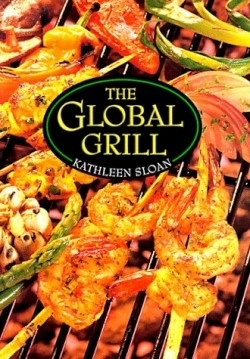The Global Grill
To those whose idea of grilling is a backyard barbecue—good plain protein and lots of it—Sloan’s compendium of marinades, rubs, sauces and intricate multipart recipes for foods like Portuguese-Style Grilled Chicken with Piri-Piri Sauce will seem marvelously superfluous. On the other hand, readers who patrol the streets of strange cities for tiny ethnic restaurants—or enjoy Pacific Rim and other hybrid cuisines—should hang on to their hats (and keep a bowl of cooked rice handy). Things are going to get a little spicy, as Sloan describes how to prepare dishes using classic Thai, Japanese, Tex-Mex, Moroccan, Sikh, Vietnamese, Lebanese and Italian seasonings. Canadian, American and British foods are also featured; the author is a Canadian writer who has lived and cooked in the United Kingdom as well.
The first section of the book presents sauces, marinades and other preparations à la carte; many of these can be prepared ahead of time and stored in the refrigerator or in a nonporous container. Sloan suggests which meats, seafoods or vegetables go best with which seasonings, but leaves the final choice up to the reader’s discretion.
Other sections include starters, main courses and sweets. Most of these have a logical link to grilling—for example, a grilled beefsteak tomato salad and a dessert of grilled oranges marinated in Grand Marnier. Practical sidebars on each page recommend complementary flavors and textures—such as serving plain rice to absorb the fire of Asian hot chiles. Sloan also emphasizes a safety point: before reusing a marinade as sauce or basting liquid, bring it to a boil. (This kills germs from uncooked meat juices in the marinade.)
One accomplished home cook commented that The Global Grill reads like a book for professional chefs. These recipes look harder than they are because Sloan uses multiple ingredient lists and the instructions are laid out without visual breaks between sections. Thus, “dressing” and “marinade” ingredients are listed before any explanation of how they fit together. Is “dressing” a stuffing for the meat or a sauce for the greens that line the platter? Some may not read far enough to find out. The recipe for Sea Scallops Aioli would be less daunting if the instructions for sauce and scallops were identified as separate processes. Also, aioli and many of the other entrée components could be cross-referenced to the sauce section, since most of Sloan’s sauces are stand-alone classics that can accompany a variety of foods.
Nevertheless, for cooks who want to prepare restaurant-type meals at home and are patient enough to parse through the recipes, this book is a healthy resource.
Reviewed by
Laurene Sorensen
Disclosure: This article is not an endorsement, but a review. The publisher of this book provided free copies of the book to have their book reviewed by a professional reviewer. No fee was paid by the publisher for this review. Foreword Reviews only recommends books that we love. Foreword Magazine, Inc. is disclosing this in accordance with the Federal Trade Commission’s 16 CFR, Part 255.

